Daves Old Computers - Apple Macintosh
Following their wildly successful AppleII
computer, Apple Computer Company pressed into new territory with the development
of the "Lisa" - the first personal computer with a fully graphical user interface
(GUI). The Lisa was too expensive and had technical problems which prevented it
from achieving the success it deserved, prompting a redesign. Reborn as the
Macintosh, Apples graphical system took off like crazy.
Click any photo to view a large high-resolution image.
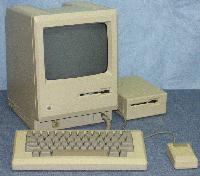 The original Macintosh. With only 128k of memory, and a single-sided 400k
floppy drive, this machine was limited, but started a revolution in the user
interface to a personal computer. As seen on the
back, this is an early "Macintosh", before the 512 came out and the
original was renamed "Macintosh 128k".
The original Macintosh. With only 128k of memory, and a single-sided 400k
floppy drive, this machine was limited, but started a revolution in the user
interface to a personal computer. As seen on the
back, this is an early "Macintosh", before the 512 came out and the
original was renamed "Macintosh 128k".
 More classic format macs:
More classic format macs:
Top: 512k, Plus, SE
Bottom: SE/30, Classic, Classic2
The 512k was donated by Rob Krten.
The Plus and 1 SE/30 were donated by Kirk Russel.
Another SE/30 was donated by Bob Johnston.
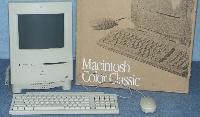 The Color Classic is a small format Mac with a color screen.
Donated by Kevin Switzer.
The Color Classic is a small format Mac with a color screen.
Donated by Kevin Switzer.
View Back.
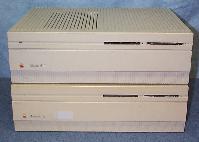 Large desktop macs:
Large desktop macs:
Top: Macintosh II
Bottom: The famous "wicked fast" Macintosh IIfx
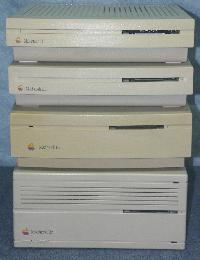 Small desk top macs:
Small desk top macs:
Top: LC and LCII - Smallest MACs
Middle: IIsi - Donated by Douglas Young.
Bottom: IIci - Donated by G. Morrison.
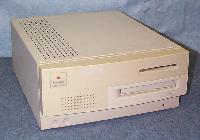 Mac Centris 650: This 68040 based "powerhouse" in its day is still considered
a good machine on the used market.
Mac Centris 650: This 68040 based "powerhouse" in its day is still considered
a good machine on the used market.
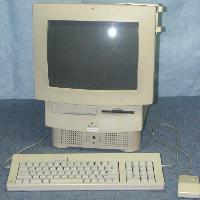 Performa 580CD: Returning to the "all in one" desktop format like the early
"classic" macs, this more recent model has a large color monitor, integrated CD
and good performance from a 68040 CPU. Unlike most macs, this one uses an IDE
hard drive.
Performa 580CD: Returning to the "all in one" desktop format like the early
"classic" macs, this more recent model has a large color monitor, integrated CD
and good performance from a 68040 CPU. Unlike most macs, this one uses an IDE
hard drive.
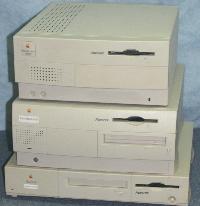 Power macs: These machines are based on the PowerPC architecture, and run the 68k OS through
processor emulation.
Power macs: These machines are based on the PowerPC architecture, and run the 68k OS through
processor emulation.
Top: PowerMac 7100 - Nubus PowerMac
Middle: G3 powermac (incomplete)
Bottom: Proforma 6100 - the first powermac.
 Before the "Powerbook" series, Apple produced this Macintosh Portable - the
first battery powered macintosh. It used an internal lead-acid rechargable
battery. The unit shown is a first edition, which does NOT have a backlit
screen. A second version was produced with a backlit screen, however it was
expensive, heavy and did not sell well. After these machines, Apple redesigned
the Portable into the PowerBook 100. Here is view of it
Closed. Here is a view from the back with the
cover removed. Note the rechargable battery which has been removed from
it's cavity and placed on top of the machine.
Before the "Powerbook" series, Apple produced this Macintosh Portable - the
first battery powered macintosh. It used an internal lead-acid rechargable
battery. The unit shown is a first edition, which does NOT have a backlit
screen. A second version was produced with a backlit screen, however it was
expensive, heavy and did not sell well. After these machines, Apple redesigned
the Portable into the PowerBook 100. Here is view of it
Closed. Here is a view from the back with the
cover removed. Note the rechargable battery which has been removed from
it's cavity and placed on top of the machine.
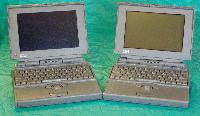 PowerBook 160 & 180 - 68030 laptop format classic Macs. Donated by Kirk Russel.
PowerBook 160 & 180 - 68030 laptop format classic Macs. Donated by Kirk Russel.
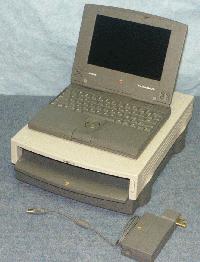 PowerBook DUO 230 with DuoDock. This (and the 210) was the first powerbook
with Docking capability. Donated by G. Morrison.
PowerBook DUO 230 with DuoDock. This (and the 210) was the first powerbook
with Docking capability. Donated by G. Morrison.
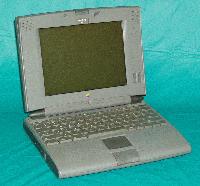 PowerBook 540 - A 68040 laptop format classic Mac. Donated by Doug Terry.
PowerBook 540 - A 68040 laptop format classic Mac. Donated by Doug Terry.
 An early Apple desktop monitor.
An early Apple desktop monitor.
 A selection of Mac keyboards.
A selection of Mac keyboards.
Top left: From the MacII/IIfx
Top Right: From the Centris/Powermacs
Middle: From the Classics and small II's
Bottom: From the MacPlus - NOT an "Apple Desktop Bus" keyboard.
 Top: A couple of Mac joysticks
Top: A couple of Mac joysticks
Middle: Pair of third party ADB mice
Bottom: MacPlus (non-ADB), and older/newer ADB mice.
1984 Mac advertisement - from Byte magazine (277k JPG).
Back to Old Computers
Copyright 2004-2007 Dave Dunfield.
 The original Macintosh. With only 128k of memory, and a single-sided 400k
floppy drive, this machine was limited, but started a revolution in the user
interface to a personal computer. As seen on the
back, this is an early "Macintosh", before the 512 came out and the
original was renamed "Macintosh 128k".
The original Macintosh. With only 128k of memory, and a single-sided 400k
floppy drive, this machine was limited, but started a revolution in the user
interface to a personal computer. As seen on the
back, this is an early "Macintosh", before the 512 came out and the
original was renamed "Macintosh 128k".













